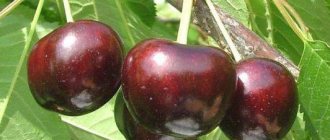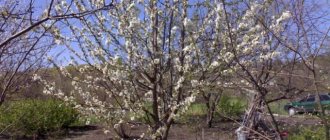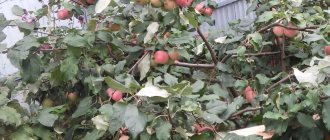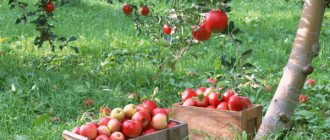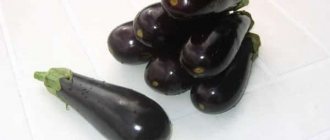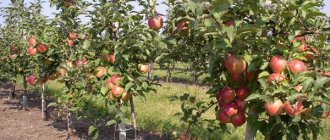Gardening » Apple tree
1
609
Article rating
Kira Stoletova
The Stroevskoe apple tree has become widespread among gardeners, which is often characterized exclusively on the positive side. The variety was created in 1982 thanks to the joint work of experienced breeders E. Sedov, E. Dolmatov, V. Zhdanov and Z. Severov.
Growing apple trees Stroevskoe
History of selection
Stroevskoe is a variety of winter apple tree, bred in 1982 on the basis of the Breeding Research Institute. The first series began to enter the fruiting period in 1991. Due to their high taste qualities, in 1995 the seedlings were assigned to the elite group. Several breeders took part in the development of the variety: Zhdanov V.V., Dolmatov E.A., Serova Z.M. and Sedov E.N.
State tests of the variety began in 1998. They were carried out simultaneously in several regions - the middle zone, the Volga region, and the Black Earth Region. The Stroevskoye apple tree variety took part in exhibitions and received a diploma and a gold medal. Since 2001, it has been listed in the state register of selection achievements.
Protection from diseases and pests
The Stroevskoe apple tree has a very strong immune system.
The variety was originally bred to be resistant to scab and fungal diseases. However, preventive measures should not be neglected. For example, the garden should be protected from powdery mildew, one of the common diseases of fruit trees. In this case, a whitish coating appears on the leaves and young shoots, which over time changes its color to brown. Due to powdery mildew, the leaves and ovaries first curl up and then completely fall off. For preventive purposes and for treatment, you need to spray trees with a solution of colloidal sulfur in early spring: 80 g of sulfur per 10 liters of water. The first treatment is carried out as soon as the first leaves appear, and then repeated again after 2 weeks.
The first sign of powdery mildew is a whitish coating on the leaves and young shoots.
Another unpleasant apple tree disease is fruit rot, or moniliosis. From the name it is easy to understand that this disease affects the fruits of the tree. As soon as affected fruits appear on the apple tree, they should be immediately removed and burned. If you bury them, you need to do this as far as possible from other trees.
Moniliosis is a fungal disease to which the Stroevskoye variety has immunity, but it would be a good idea to prevent fruit rot
As a preventative measure, it is necessary to carry out detailed pruning of trees, as well as improve lighting and ventilation of the crown. As a result, the crown should be transparent and also well filled with fruit growing wood.
During the growing season, spraying is carried out with one of the preparations: 1% Bordeaux mixture, 1% suspension of colloidal sulfur (dilute 100 g of the preparation in 10 liters of water) or Tsiram (100 g per 10 liters) in the following periods: first - 3– 4 days before flowering, the second - when the first drop appears, the third - 10-12 days after the second. In the fall, after harvesting, the tree should be treated with copper sulfate (100 g per 10 liters of water), 2–3 liters per tree.
However, as already mentioned, this variety of apple trees is not susceptible to scab. Accordingly, fruit rot affects a tree very rarely.
As for the negative impact of pests, in this regard the Stroevskoye variety has a number of advantages. Any damage from pests will not harm the tree and does not require treatment, as it has strong immunity. The Stroevskoe apple tree does not need additional preventive measures to protect against pests.
Description of the Stroevskoye apple tree with photo
The description of the Stroevskoye apple variety provides the main characteristics, photos of the tree and fruits. The most important parameters are described below.
Crown
The trees are medium-sized and grow quickly. They produce a wide-pyramidal crown, shoots are formed with medium density. The bark has a smooth gray surface. Fruiting is of mixed type: fruits appear on ringlets and spears.
The shoots of the Stroevskoe apple tree themselves are of medium thickness, brown in color, and have intense pubescence. The shape is cranked, it can also be faceted. There is a noticeable curvature in the shape of an arc. Lentils are small and sparse. The buds of the Stroevskoe apple tree also have pubescence, a conical shape, they are pressed against the shoots.
The foliage is large, the color is light green, there is a yellowish tint. The shape is oblong, elongated-ovoid, pointed tips. They twist in a spiral. The surface of the leaves of the Stroevskoye apple tree is wrinkled, glossy, and has rough venation. The shape of the leaf is concave, with a noticeable bend towards the bottom. The edges of the leaves are wavy and jagged. The petioles are of medium length, quite thick, and have a fleecy coating.
The crown is spreading, so trees need to be planted at a distance of at least 4 m
The inflorescences of the Stroevskoye apple tree are of the corymbose type, each of them has 4-6 flowers. The buds are light pink. The flowers are small in size, flat in shape. The petals do not close, they are round, the color is pink, but more saturated. The pedicels of the Stroevskoe apple tree are small, the pistils are level with the anthers. The pistil columns are fused and have no pubescence.
Description of fruits
Most of the fruits of the Stroevskoe apple tree are medium in size, but there are also large ones. The most common weight is 110-120 g, the maximum is 170-180 g. They are conical in shape, medium flattened, slightly beveled. The ribs are almost invisible. The surface is smooth and shines very well in the sun. There is practically no waxy coating.
During harvesting, the fruits of the Stroevskoye apple tree have a greenish-yellow color. They are of the winter type and store well. Gradually become golden yellow. The stripes are merging, a reddish-crimson blush is noticeable.
On the surface of the fruits of the Stroevskoye apple tree you can see a large number of large subcutaneous points. They have a light gray color. The stalks are small in thickness, have a pointed conical shape, and are slightly rusty. The cups are closed, the saucers are small, narrow, and grooved in shape. Seed chambers are closed. The seeds themselves are colored light brown, they are quite narrow, and have a conical shape.
Important! The fruits are storable and tolerate long-distance transportation well. Therefore, trees can be grown both for personal consumption and for sale.
Features of ripening and fruiting
The variety is characterized by a mixed type of fruiting. Flower buds are formed both on the ringlets and on the fruit twigs. The stalks are short, of medium thickness, the apples stick well to the tree and are not prone to shedding.
Beginning of fruiting
begins to bear fruit relatively The first few fruits appear in the fourth or fifth year. Full fruiting begins in the seventh to ninth year of the plant’s life, and under unfavorable conditions even later.
Full fruiting of the apple tree begins at 7-9 years.
Deadlines
Blooms
Depending on the region and weather conditions, flowering periods range from the beginning to the third ten days of May.
The inflorescences include 4-6 buds of white and pink color and the appearance of the flowering tree is completely unique.
Fruit ripening
Apples ripen by the end of September, and in order for them to achieve good consumer ripeness, it is better to keep them for another month.
Stroevskoe apples ripen by the end of September.
Fruit storage
The variety is very good for long-term storage. At favorable temperatures and humidity, apples fully retain their consumer and commercial qualities until the end of February, and in special refrigeration chambers until the end of spring.
Characteristics of the Stroevskoe apple tree
Among the important characteristics of the variety, one should consider the evaluation of the taste of the fruit, the yield indicator, and frost resistance. The main parameters are described below.
Taste qualities
One of the most important advantages of the Stroevskoye apple tree is its excellent taste. Based on the tasting results, they are rated 4.4 points out of 5. At the same time, external attractiveness is determined at approximately the same level - 4.5 points.
A table variety, the apples are quite sweet, with a pleasant sourness. The pulp is white, quite dense and juicy. The aroma is moderate. The composition includes the following components:
- simple sugars (mass fraction 9%);
- acids (up to 0.52%);
- vitamin C (more than 8.5 mg per 100 g);
- P-active compounds (more than 430 mg per 100 g).
The fruits have a pronounced sweet taste
Apples of the Stroevskoe variety are used fresh, as they store well, and over time the taste only improves. So, the pulp initially has a greenish tint, and then becomes classic white. The fruits are used in various preparations, for example, in jam, juices.
Ripening time for the Stroevskoye apple tree
Technical ripeness is reached in the second ten days of September (usually from the 15th to the 20th). Moreover, it is recommended to consume them not on these days, but after 4-5 weeks, i.e. approximately from mid-October. The fruits of the Stroevskoye apple tree are well stored. Even without creating suitable conditions, they manage to survive until the middle or second half of February.
Productivity
The yield of the Stroevskoye variety is good - from mature trees (8-10 years old) you can collect 129 centners per hectare during industrial cultivation. From one tree you can collect more than 50 kg of ripe fruits. At the same time, the early pregnancy rate is low. Trees often begin to bear fruit only 6-7 years after planting. There are rarely cases of early harvest yield from the fourth or fifth year of life.
Frost resistance of the Stroevskoye apple tree
The frost resistance of this apple tree is relatively good. It is noted that even at a temperature of -40 (created under artificial conditions), the deep layers of the bark and cambium do not freeze. The buds were partially frozen - 1.2 points, the wood of the branches - 1.6.
Pollinators of the Stroevskoe apple tree
The Stroevskoye apple tree can bear fruit on its own, but pollinators are required to maintain good yields. Among them you can choose the Veteran variety or the Orlovsky Kandil variety. The Memory of a Warrior apple tree will also work.
Where is it grown?
The variety has been successfully tested in the regions of the middle zone, the Volga region and the Black Earth region. It can also be grown in the southern regions, in the North Caucasus. Due to its high winter hardiness, cultivation is possible in the Urals.
Disease resistance
The Stroevskoye apple tree variety is quite resistant to diseases, as well as to major pests. When growing, it is recommended to carry out preventive spring treatments.
Description of the variety Vostochnoe
The apples are small, but despite this, they are in demand. The fruits are beautiful, ruddy, aromatic and tasty, easy to transport and can even lie in the cellar for some time. The main disadvantage of the variety is considered to be the unsharp frequency of fruiting, that is, yields may temporarily decrease during rest years. Recommended for individual cultivation and industrial cultivation.
Apples: what they look like
The skin is smooth, shiny, dense and elastic, and can well protect the pulp from mechanical damage. When ripe, it becomes covered with a noticeable oily coating, which does not affect the color in any way, it just makes the apples seem fatty. The main color of the skin is yellow or golden yellowish. The top blush is bright red, dense, blurry-transparent, occupies at least 75-85% of the surface, and completely hides the main tone during the period of consumer maturity. There are a lot of subcutaneous points, they are light, not very visible, they are small, greenish or gray-green. The easiest way to track chemical composition is by the following set of original indicators:
- P-active substances (catechins) – 344.3 milligrams.
- Ascorbic acid (vitamin C) – 19.5 milligrams.
- Fructose (total sugars) – 13.4%.
- Pectins – 12.2%.
- Titratable acids – 0.8%.
The pulp of Tubinsky is very tender, fine-grained, medium-dense, extremely juicy, crispy, non-prickly, and has a pleasant consistency. It is aromatic, has a sweeter taste with a characteristic wine-spicy sourness, it is considered harmonious, dessert, balanced. From professionals, apples score 4.5 out of 5 for appearance and taste.
Eastern apple tree (Tubinsky): characteristics
Crown and root system
It can stretch to a maximum of 2.7-3.2 meters
The leaves are medium-sized or large, oval, slightly elongated, short-pointed, dense and leathery. The tip is twisted by a propeller, the edges are serrated, crenate, wavy, jagged. The plate is delicately nervated, matte, with light felt pubescence on the reverse side. The root system is deeply recessed, powerful, branched, mostly fibrous, but can also be taprooted, depending on the rootstock.
Productivity and pollination
Compared to European apple trees, Far Eastern and northern apple trees seem unimpressive, but you should definitely make allowances, first of all, for the compactness of the trunks, and secondly, for the harsh conditions of the growing region, because fruit trees can rarely survive in them.
Apple trees are completely sterile to themselves, so they definitely need third-party pollinators for fruiting. If possible, it is better to plant trees interspersed or at least within 50-150 meters from other varieties blooming at the same time.
Winter hardiness and disease resistance
The variety is unusually winter-hardy; it is not afraid not only of low temperatures, but even of their sharp blows, even at high humidity, which the majority of apple trees are not able to survive. Frosts down to -40-43°C with proper shelter and preparation for wintering are not at all scary for Tubinsky.
The tree's resistance to scab is consistently high, although it does not have immunity. Even in the years of the most severe epiphytoties, it is mainly the leaves that suffer, while the fruits remain mostly edible. Parasites can infect the variety, and bacterial threats also occur. Therefore, it is necessary to carry out prevention in time, then the risks are reduced to zero.
Vostochny has no subspecies, but is grown on different rootstocks. The most popular is the standard one, but dwarfs and semi-dwarfs are also in constant demand. At the same time, winter hardiness is significantly reduced, so they have to be covered even more carefully. The variety can be easily formed into a slate tree, which can be covered with soil or snow for the winter.
Advantages and disadvantages
The Stroevskoye apple tree is quite common in Russia and neighboring countries. It is valued by gardeners and farmers for its high yield, good taste, and marketability (keeping quality, appearance). The culture is winter-hardy, so it can be grown in a variety of regions.
The apples are quite large and have an attractive presentation
Pros:
- high productivity;
- excellent taste;
- good keeping quality;
- transportability;
- relatively high winter hardiness;
- stable immunity.
Minuses:
- the crop bears fruit only from the seventh year;
- for high yields a pollinator is needed;
- The crown is spreading, so it takes up quite a lot of space.
Planting an apple tree Stroevskoye
In most regions, it is better to plan planting in the fall - the period from late September to mid-October. But in areas with severe winters, for example, in the Urals, planting in early April is preferable.
The growing place should be sunny and dry, without stagnant water. The air flow must be free (not located next to a fence or building). However, it is advisable to protect from draft winds.
Standard technology for planting apple trees of the Stroevskoe variety:
- Dig holes 80*100 cm at a distance of 4 m.
- Lay a layer of small stones.
- Prepare fertile garden soil with peat, humus and sand (2:1:1:1).
- Root the seedling in the center, dig in so that the root collar remains 5-7 cm above ground level.
- Water with settled water and mulch.
Specifics of planting fruit crops
In order to grow a good fruit-bearing tree, you need to choose a high-quality seedling, follow planting technology, and properly care for the plant.
Deadlines
It is best to plant young apple trees in the spring (before sap flow begins), but autumn planting is quite acceptable.
In the middle zone this is the end of September - beginning of October, in the northern regions 7-10 days earlier. It is important that newly planted trees have time to form new roots before the onset of persistent cold weather.
Site selection and preparation
For growing apple trees of this variety, leached chernozems, floodplain loamy, sandy loam soils, illuminated, elevated areas are favorable.
The proximity of groundwater greatly inhibits the growth and development of trees. The permissible depth of groundwater is 2-2.5 m from the soil surface.
Before planting seedlings, the selected area is cleared of weeds, plant debris, and dug up.
How to make drainage for an apple tree before planting
If groundwater lies close to the soil surface, the planting site is chosen in a lowland, or the soil in the area is clayey, drainage should be done before planting the apple tree. To do this, 10–15 cm of crushed stone, river pebbles, sand and gravel mixture, and broken bricks are poured into the bottom of the planting pit.
Preparing seedlings
Before planting, seedlings are prepared as follows:
- if immediate planting is not possible, seedlings are buried;
- cut damaged roots to a healthy place;
- Dip the roots into water, or even better, into an earthen mash with added growth material for 2–3 hours.
Technological process of disembarkation
2–3 weeks before planting, prepare a planting hole, dimensions 60 x 100 cm. Fertilizers mixed with soil are added to the planting hole. A mound is poured into the bottom of the hole, the roots are spread out on it and covered with soil or a mixture of compost and earth (1:3). The tree is shaken periodically. When the roots are covered, the soil is compacted evenly. Form a hole for watering. Water the seedling at the rate of 2 buckets per tree.
What can you plant in your neighborhood?
The apple tree does not like berries, juniper, or rowan. She is friends with other cultures.
Care instructions
Caring for the Stroevskoye apple tree is standard. In the summer, in the absence of rain, it is necessary to provide regular watering every 10-15 days (four buckets per adult tree). You also need to fertilize - nitrogen compounds in the spring, potassium compounds and superphosphate are used during the budding period.
The soil is periodically loosened and weeded. Sanitary pruning is carried out every spring. To prevent diseases and pests in the spring, they are also treated with fungicides, for example, Bordeaux mixture.
Planting and care
To ensure a good harvest, it is extremely important to choose and properly prepare the right place for planting.
Stroevskoe is recommended to be planted in fertile, well-fertilized soil.
It is imperative to provide for soil drainage.
This is necessary for the normal functioning of the tree: if the groundwater rises very high, the apple tree will begin to hurt and will soon die.
It is also important to provide the tree with sufficient lighting.
It is better to plant young apple trees in areas with high or medium light, avoiding dark places.
The survival rate of the Stroevskoe variety is quite high. In most cases, young seedlings withstand the first (most difficult) years of their life very well.
At the same time, caring for these trees is quite simple. You don't have to make any complicated efforts.
It is only necessary to fertilize the soil regularly (preferably once a year) , as well as trim excess branches, otherwise in particularly fruitful years they may not be able to withstand the heavy load of ripe fruits.
Collection and storage
The Stroevskoe apple tree is harvested from September 15 to 20. They are stored in wooden boxes or other containers in cellars and basements under the following conditions:
- complete darkness;
- temperature in the range of 2-8 degrees Celsius;
- humidity up to 70%
- regular ventilation.
Even without creating such conditions, the harvest will last until the end of February. If stored according to the rules, the fruits are good until late spring.
Apples can be stored without loss of quality until the end of winter
Growing regions
It will be most successful to grow the Stroevskoye apple tree in the Moscow region, as well as in the central part of Russia, since the climatic conditions are most suitable here. Only young trees need care here in dry, hot summers. In addition, the tree is periodically fed. Here it is possible to grow both dwarf and medium-sized apple trees.
In Siberia, the Stroevskoye apple tree variety is difficult to grow. It is necessary to insulate the tree before the winter period, namely, lay out a thick layer of mulch under the tree trunk, insulate the trunk itself, and it is advisable to shape the crown of the tree so that its growth is as low as possible. This will help protect the apple tree from frost.
The high frost resistance of the Stroevskoe apple tree makes it possible to grow it in the Urals. However, preventive measures against various fungal diseases will also not hurt here. This is especially true in years when there is too much rainfall. Before the winter period, the trunk should be insulated with spruce branches or other covering material. This will not only protect the tree from frost, but will also protect it from rodents. In addition, do not forget about mulching and lay out a thick layer of sawdust or rotted manure.

